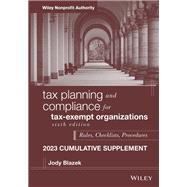An essential, timesaving guide for accountants, lawyers, nonprofit executives and directors, consultants, and volunteers – Completely updated for 2023
This book is an indispensable guide to navigating the complex maze of nonprofit tax rules and regulations. A clear and fully cited description of the requirements for the various categories of tax-exempt entities from public charities, private foundations, civic associations, business leagues, and social clubs to title-holding companies and governmental entities can be found. Practical guidance on potential for income tax on revenue-producing enterprises along with explanations of many exceptions to taxability is provided. Issues raised by Internet activity, advertising, publishing, providing services, and much more are explained.
This useful annual supplement for 2023 will cover any and all changes and updates to the law within the previous 12 month period and will keep accountants, attorneys, and others up-to-date for the year ahead.
- Features a variety of sample documents for private foundations, including penalty abatement requests and sharing space agreements
- Provides helpful practice aids, such as a comparison of the differences between public and private charities, charts reflecting lobbying limits for different types of entities, and listings of rulings and cases that illustrate permissible activity for each type of organizations compared to impermissible activity








